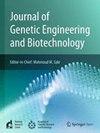Whole-genome sequencing and biofilm gene characterization in multidrug-Resistant Staphylococcus aureus clinical strains
IF 2.8
Q3 Biochemistry, Genetics and Molecular Biology
Journal of Genetic Engineering and Biotechnology
Pub Date : 2025-06-15
DOI:10.1016/j.jgeb.2025.100521
引用次数: 0
Abstract
Staphylococcus aureus is known as a significant contributor to a variety of severe, life-threatening illnesses. Infectious diseases associated with biofilm-producing S. aureus can lead to a substantial increase in morbidity and mortality rates. This study aimed to characterize the whole genomes of eight clinically multidrug-resistant S. aureus strains isolated from several types of human infections sites from Hail Hospital, Saudi Arabia. Biofilm production was evaluated using Congo-red agar plates (CRA), polystyrene microtiter plate technique (MtP), and adherence to human epithelial cells (Hep 2). Additionally, adhesion to abiotic surface (Polyethylene, glass, stainless steel) was assessed using scanning electron microscopy (SEM). Then whole genome sequencing was conducted for all strains to analyze the virulome, resistome and phylogenome using different bioinformatic tools.
Our results revealed that all S. aureus strains were slime producer on CRA plates with pigmented colonies (black and nearly black morphotypes) and were also able to form biofilm on the surface of several materials with different degrees. All tested strains adhere to Hep2 cell lines with a percentage of infected cells ranging from 45.0 % ± 0.078 to 92.0 % ± 0.022, and a total number of S. aureus/100 cells varying from 5.11 ± 2.14 (Strain S22) to 20.25 ± 5.15 (Strain S14). These results were correlated with those obtained from genome annotation highlighting that all multidrug resistant and biofilm-producing S. aureus strains harbored four ica genes (icaA, icaB, icaC, icaD) and their regulator icaR), clumping factor A and B (clfA and clfB genes), fibronectin binding proteins (fnbA in all strains and fnbB in 87.5 % of tested strains), elastin binding protein (ebps gene), extracellular adherence protein (Eap), staphylococcal protein A (spa gene), and Ser-Asp rich fibrinogen-binding proteins (sdrC). Most of the studied strains contained six to ten genomic islands associated with virulence factors, phage proteins, transcriptional regulators, insertion sequences and antimicrobial resistance genes. The study reported the presence of key adhesion-related genes underscores the colonization potential and pathogenicity in our strains. Additionally, the identification of multiple genomic islands associated with virulence and antimicrobial resistance highlights the need for vigilant monitoring in clinical settings.
耐多药金黄色葡萄球菌临床菌株的全基因组测序和生物膜基因鉴定
众所周知,金黄色葡萄球菌是导致多种严重、危及生命的疾病的重要因素。与产生物膜金黄色葡萄球菌相关的传染病可导致发病率和死亡率的大幅增加。本研究旨在描述从沙特阿拉伯Hail医院几种人类感染地点分离的8株临床耐多药金黄色葡萄球菌菌株的全基因组特征。采用刚果红琼脂板(CRA)、聚苯乙烯微滴板技术(MtP)和粘附人上皮细胞(Hep 2)对生物膜的生产进行评估。此外,使用扫描电子显微镜(SEM)评估与非生物表面(聚乙烯,玻璃,不锈钢)的粘附性。然后对所有菌株进行全基因组测序,利用不同的生物信息学工具分析病毒组、抵抗组和系统基因组。结果表明,所有金黄色葡萄球菌菌株都能在有色菌落(黑色和近黑色形态)的CRA板上产生黏液,并能在几种材料表面不同程度地形成生物膜。所有被试菌株均粘附于Hep2细胞系,感染细胞百分率为45.0%±0.078 ~ 92.0%±0.022,金黄色葡萄球菌总数为5.11±2.14(菌株S22) ~ 20.25±5.15(菌株S14)。这些结果与基因组注释结果相关,强调所有耐多药和产生生物膜的金黄色葡萄球菌菌株都含有4个ica基因(icaA, icaB, icaC, icaD)及其调节因子icaR),聚集因子A和B (clfA和clfB基因),纤维连接蛋白结合蛋白(所有菌株为fnbA, 87.5%的测试菌株为fnbB),弹性蛋白结合蛋白(ebps基因),细胞外粘附蛋白(Eap),葡萄球菌蛋白A (spa基因)。和富含Ser-Asp的纤维蛋白原结合蛋白(sdrC)。所研究的大多数菌株含有6至10个与毒力因子、噬菌体蛋白、转录调节因子、插入序列和抗菌素耐药基因相关的基因组岛。该研究报告了关键粘附相关基因的存在,强调了我们菌株的定植潜力和致病性。此外,与毒力和抗菌素耐药性相关的多个基因组岛的鉴定突出了在临床环境中进行警惕监测的必要性。
本文章由计算机程序翻译,如有差异,请以英文原文为准。
求助全文
约1分钟内获得全文
求助全文
来源期刊

Journal of Genetic Engineering and Biotechnology
Biochemistry, Genetics and Molecular Biology-Biotechnology
CiteScore
5.70
自引率
5.70%
发文量
159
审稿时长
16 weeks
期刊介绍:
Journal of genetic engineering and biotechnology is devoted to rapid publication of full-length research papers that leads to significant contribution in advancing knowledge in genetic engineering and biotechnology and provide novel perspectives in this research area. JGEB includes all major themes related to genetic engineering and recombinant DNA. The area of interest of JGEB includes but not restricted to: •Plant genetics •Animal genetics •Bacterial enzymes •Agricultural Biotechnology, •Biochemistry, •Biophysics, •Bioinformatics, •Environmental Biotechnology, •Industrial Biotechnology, •Microbial biotechnology, •Medical Biotechnology, •Bioenergy, Biosafety, •Biosecurity, •Bioethics, •GMOS, •Genomic, •Proteomic JGEB accepts
 求助内容:
求助内容: 应助结果提醒方式:
应助结果提醒方式:


